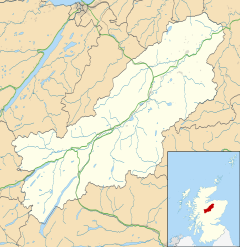
Fort William is a town in Lochaber in the Scottish Highlands, located on the eastern shore of Loch Linnhe. As of the 2011 Census, Fort William had a population of 10,459, making it the second largest settlement in the Highland council area, and the second largest settlement in the whole of the Scottish Highlands; only the city of Inverness has a larger population.

The West Highland Way is a linear long-distance route in Scotland. It is 154 km long, running from Milngavie north of Glasgow to Fort William in the Scottish Highlands, with an element of hill walking in the route. The trail, which opened in 1980, was Scotland's first officially designated Long Distance Route, and is now designated by NatureScot as one of Scotland's Great Trails. It is primarily intended as a long distance walking route, and whilst many sections are suitable for mountain biking and horseriding there are obstacles and surfaces that will require these users to dismount in places.

The Highland Railway (HR) was one of the smaller British railways before the Railways Act 1921, operating north of Perth railway station in Scotland and serving the farthest north of Britain. Based in Inverness, the company was formed by merger in 1865, absorbing over 249 miles (401 km) of line. It continued to expand, reaching Wick and Thurso in the north and Kyle of Lochalsh in the west, eventually serving the counties of Caithness, Sutherland, Ross & Cromarty, Inverness, Perth, Nairn, Moray and Banff. Southward it connected with the Caledonian Railway at Stanley Junction, north of Perth, and eastward with the Great North of Scotland Railway at Boat of Garten, Elgin, Keith and Portessie.
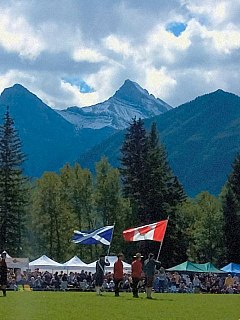
Highland games are events held in spring and summer in Scotland and other countries with a large Scottish diaspora, as a way of celebrating Scottish and Celtic culture, especially that of the Scottish Highlands. Certain aspects of the games are so well known as to have become emblematic of Scotland, such as the bagpipes, the kilt, and the heavy events, especially the caber toss. While centred on competitions in piping and drumming, dancing, and Scottish heavy athletics, the games also include entertainment and exhibits related to other aspects of Scottish and Gaelic cultures.

The Great North of Scotland Railway (GNSR) was one of the two smallest of the five major Scottish railway companies prior to the 1923 Grouping, operating in the north-east of the country. Formed in 1845, it carried its first passengers the 39 miles (63 km) from Kittybrewster, in Aberdeen, to Huntly on 20 September 1854. By 1867 it owned 226+1⁄4 route miles (364.1 km) of line and operated over a further 61 miles (98 km).

Crianlarich is a village in Stirling council area and in the registration county of Perthshire, Scotland, around 6 miles (10 km) north-east of the head of Loch Lomond. The village bills itself as "the gateway to the Highlands".

The Highland Main Line is a railway line in Scotland. It is 118 mi (190 km) long and runs through the Scottish Highlands linking a series of small towns and villages with Perth at one end and Inverness at the other. Today, services between Inverness and Edinburgh, Glasgow and London use the line. At Inverness the line connects with the Far North Line, the Aberdeen-Inverness Line and services on the Kyle of Lochalsh Line. All trains are diesel-powered.

Lairg is a village and parish in Sutherland, Scotland. It has a population of 891 and is at the south-eastern end of Loch Shin.

Oban railway station is a railway station serving Oban in Scotland. It is the terminus of one branch of the highly scenic West Highland Line 101.3 miles (163 km) north of Glasgow Queen Street. It was originally the terminus of the Callander and Oban Railway. Services are operated by Abellio ScotRail.

Inverness railway station is the railway station serving the Scottish city of Inverness.

Rannoch railway station, on the West Highland Line, serves the area of Rannoch in Perth and Kinross, Scotland. Its remote location on Rannoch Moor is picturesque and makes it attractive to walkers. The station has a tea room and visitor centre. In 2017, Simon Jenkins reported it to be one of the best 100 stations in Britain.
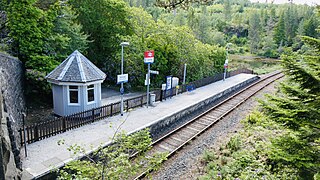
Duncraig railway station is a remote railway station by the shore of Loch Carron on the Kyle of Lochalsh Line, serving Duncraig Castle, a mansion near Plockton, in the Highland council area of northern Scotland. It was originally a private station, and features a small, unique octagonal waiting room. The station is unstaffed and is a request stop.

Plockton railway station is a railway station on the Kyle of Lochalsh Line, serving the village of Plockton in the Highlands, north-west Scotland. The station is now unstaffed.

Dunrobin Castle railway station is a railway station on the Far North Line in Scotland, serving Dunrobin Castle near the village of Golspie in the Highland council area. It is open only during the summer when the castle itself is open, and is closed from late October to March every year. It was also used in the 4th and 5th Harry Potter films as Hogsmeade.
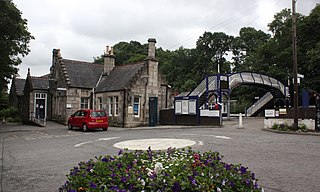
Pitlochry railway station, located on the Highland main line, serves the town of Pitlochry in Perth and Kinross, Scotland. It is served regularly by Abellio ScotRail trains between Glasgow or Edinburgh and Inverness, the daily Caledonian Sleeper service to and from London Euston and the daily London North Eastern Railway service between London King's Cross and Inverness via York along the East Coast Main Line.
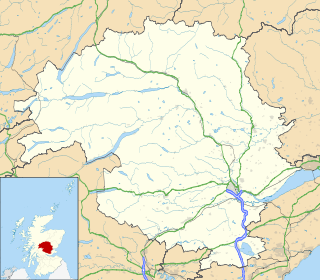
Ballinluig is a village in Perth and Kinross, Scotland. It lies on the banks of the River Tummel in Logierait Parish, and is approximately 4 miles southeast of Pitlochry. It developed with the building of the Highland Railway, and sat where a branch line went off to Aberfeldy, both the branch line and Ballinluig station were closed in 1965.

The Wick and Lybster Light Railway was a light railway opened in 1903, with the intention of opening up the fishing port of Lybster, in Caithness, Scotland, to the railway network at Wick. Its construction was heavily supported financially by local government and the Treasury. It was worked by the Highland Railway.

The A861 road is a circuitous, primarily coastal, road in Highland, Scotland.

Gedintailor is a crofting village, lying on the shores of the Narrows of Raasay on the east coast of the island of Skye in Scotland and is in the council area of Highland.

St Columba's-by-the-Castle is a congregation of the Scottish Episcopal Church in central Edinburgh, Scotland. The church is located close to Edinburgh Castle, on the south slope of Castle Hill, and is protected as a category B listed building.

